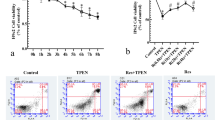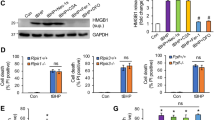Abstract
Zinc homeostasis is essential for maintaining redox balance, cell proliferation, and apoptosis. However, excessive zinc exposure is toxic and leads to mitochondrial dysfunction. In this study, we established a zinc overload model by treating rat cardiomyocyte H9c2 cells with Zn2+ at different concentrations. Our results showed that zinc overload increased LDH and reactive oxygen species (ROS) levels, leading to cell death, mitochondrial membrane potential decrease and impaired mitochondrial function and dynamics. Furthermore, zinc overload activated the PINK1/Parkin signaling pathway and induced mitochondrial autophagy via ROS, while NAC inhibited mitophagy and weakened the activation of PINK1/Parkin pathway, thereby preserving mitochondrial biogenesis. In addition, our data also showed that Mfn2 deletion increased ROS production and exacerbated cytotoxicity induced by zinc overload. Our results therefore suggest that Zn2+-induced ROS generation causes mitochondrial autophagy and mitochondrial dysfunction, damaging H9c2 cardiomyocytes. Additionally, Mfn2 may play a key role in zinc ion-mediated endoplasmic reticulum and mitochondrial interactions. Our results provide a new perspective on zinc-induced toxicology.










Similar content being viewed by others
Data Availability
The data used to support the findings of this study are included within the article.
References
Rahimzadeh, M. R., Rahimzadeh, M. R., Kazemi, S., & Moghadamnia, A. A. (2020). Zinc poisoning—Symptoms, causes, treatments. Mini Reviews in Medicinal Chemistry, 20, 1489–1498. https://doi.org/10.2174/1389557520666200414161944
Zhao, T., Huang, Q., Su, Y., Sun, W., Huang, Q., & Wei, W. (2019). Zinc and its regulators in pancreas. Inflammopharmacology, 27, 453–464. https://doi.org/10.1007/s10787-019-00573-w
Knies, K. A., & Li, Y. V. (2021). Zinc cytotoxicity induces mitochondrial morphology changes in hela cell line. International Journal of Physiology, Pathophysiology and Pharmacology, 13, 43–51.
Di Meo, S., & Venditti, P. (2020). Evolution of the knowledge of free radicals and other oxidants. Oxidative Medicine and Cellular Longevity, 2020, 9829176. https://doi.org/10.1155/2020/9829176
Chen, G., Kroemer, G., & Kepp, O. (2020). Mitophagy: An emerging role in aging and age-associated diseases. Frontiers in Cell and Developmental Biology, 8, 200. https://doi.org/10.3389/fcell.2020.00200
Luo, Y., Ma, J., & Lu, W. (2020). The significance of mitochondrial dysfunction in cancer. International Journal of Molecular Sciences. https://doi.org/10.3390/ijms21165598
Xiao, B., Kuruvilla, J., & Tan, E. K. (2022). Mitophagy and reactive oxygen species interplay in Parkinson’s disease. NPJ Parkinson’s Disease, 8, 135. https://doi.org/10.1038/s41531-022-00402-y
Ashrafi, G., & Schwarz, T. L. (2013). The pathways of mitophagy for quality control and clearance of mitochondria. Cell Death and Differentiation, 20, 31–42. https://doi.org/10.1038/cdd.2012.81
Mekala, N. K., Kurdys, J., Depuydt, M. M., Vazquez, E. J., & Rosca, M. G. (2019). Apoptosis inducing factor deficiency causes retinal photoreceptor degeneration. The protective role of the redox compound methylene blue. Redox Biology, 20, 107–117. https://doi.org/10.1016/j.redox.2018.09.023
de Brito, O. M., & Scorrano, L. (2008). Mitofusin 2 tethers endoplasmic reticulum to mitochondria. Nature, 456, 605–610. https://doi.org/10.1038/nature07534
Mourier, A., Motori, E., Brandt, T., Lagouge, M., Atanassov, I., Galinier, A., Rappl, G., Brodesser, S., Hultenby, K., Dieterich, C., & Larsson, N. G. (2015). Mitofusin 2 is required to maintain mitochondrial coenzyme Q levels. The Journal of Cell Biology, 208, 429–442. https://doi.org/10.1083/jcb.201411100
Sun, T., Ding, W., Xu, T., Ao, X., Yu, T., Li, M., Liu, Y., Zhang, X., Hou, L., & Wang, J. (2019). Parkin regulates programmed necrosis and myocardial ischemia/reperfusion injury by targeting cyclophilin-D. Antioxidants and Redox Signaling, 31, 1177–1193. https://doi.org/10.1089/ars.2019.7734
Zhou, H., Zhang, Y., Hu, S., Shi, C., Zhu, P., Ma, Q., Jin, Q., Cao, F., Tian, F., & Chen, Y. (2017). Melatonin protects cardiac microvasculature against ischemia/reperfusion injury via suppression of mitochondrial fission-VDAC1-HK2-mPTP-mitophagy axis. Journal of Pineal Research. https://doi.org/10.1111/jpi.12413
Yin, J., Guo, J., Zhang, Q., Cui, L., Zhang, L., Zhang, T., Zhao, J., Li, J., Middleton, A., Carmichael, P. L., & Peng, S. (2018). Doxorubicin-induced mitophagy and mitochondrial damage is associated with dysregulation of the PINK1/parkin pathway. Toxicology In Vitro: An International Journal Published in Association with BIBRA, 51, 1–10. https://doi.org/10.1016/j.tiv.2018.05.001
Cao, Y., Chen, Z., Hu, J., Feng, J., Zhu, Z., Fan, Y., Lin, Q., & Ding, G. (2021). Mfn2 regulates high glucose-induced MAMs dysfunction and apoptosis in podocytes via PERK pathway. Frontiers in Cell and Developmental Biology, 9, 769213. https://doi.org/10.3389/fcell.2021.769213
Chen, Y., Csordás, G., Jowdy, C., Schneider, T. G., Csordás, N., Wang, W., Liu, Y., Kohlhaas, M., Meiser, M., Bergem, S., Nerbonne, J. M., Dorn, G. W., 2nd., & Maack, C. (2012). Mitofusin 2-containing mitochondrial-reticular microdomains direct rapid cardiomyocyte bioenergetic responses via interorganelle Ca(2+) crosstalk. Circulation Research, 111, 863–875. https://doi.org/10.1161/circresaha.112.266585
Chen, Y., Sparks, M., Bhandari, P., Matkovich, S. J., & Dorn, G. W., II. (2014). Mitochondrial genome linearization is a causative factor for cardiomyopathy in mice and Drosophila. Antioxidants and Redox Signaling, 21, 1949–1959. https://doi.org/10.1089/ars.2013.5432
He, Y., Fu, Y., Xi, M., Zheng, H., Zhang, Y., Liu, Y., Zhao, Y., Xi, J., & He, Y. (2020). Zn(2+) and mPTP mediate resveratrol-induced myocardial protection from endoplasmic reticulum stress. Metallomics: Integrated Biometal Science, 12, 290–300. https://doi.org/10.1039/c9mt00264b
King, J. C., Shames, D. M., & Woodhouse, L. R. (2000). Zinc homeostasis in humans. The Journal of Nutrition, 130, 1360s–1366s. https://doi.org/10.1093/jn/130.5.1360S
Liuzzi, J. P., & Cousins, R. J. (2004). Mammalian zinc transporters. Annual Review of Nutrition, 24, 151–172. https://doi.org/10.1146/annurev.nutr.24.012003.132402
Zilinyi, R., Czompa, A., Czegledi, A., Gajtko, A., Pituk, D., Lekli, I., & Tosaki, A. (2018). The cardioprotective effect of metformin in doxorubicin-induced cardiotoxicity: The role of autophagy. Molecules (Basel, Switzerland). https://doi.org/10.3390/molecules23051184
Botelho, A. F. M., Miranda, A. L. S., Freitas, T. G., Milani, P. F., Barreto, T., Cruz, J. S., & Melo, M. M. (2020). Comparative cardiotoxicity of low doses of digoxin, Ouabain, and Oleandrin. Cardiovascular Toxicology, 20, 539–547. https://doi.org/10.1007/s12012-020-09579-1
Klionsky, D. J. (2007). Autophagy: From phenomenology to molecular understanding in less than a decade. Nature Reviews: Molecular Cell Biology, 8, 931–937. https://doi.org/10.1038/nrm2245
Mizushima, N., Levine, B., Cuervo, A. M., & Klionsky, D. J. (2008). Autophagy fights disease through cellular self-digestion. Nature, 451, 1069–1075. https://doi.org/10.1038/nature06639
Sciarretta, S., Maejima, Y., Zablocki, D., & Sadoshima, J. (2018). The role of autophagy in the heart. Annual Review of Physiology, 80, 1–26. https://doi.org/10.1146/annurev-physiol-021317-121427
Chen, K., Xu, X., Kobayashi, S., Timm, D., Jepperson, T., & Liang, Q. (2011). Caloric restriction mimetic 2-deoxyglucose antagonizes doxorubicin-induced cardiomyocyte death by multiple mechanisms. The Journal of Biological Chemistry, 286, 21993–22006. https://doi.org/10.1074/jbc.M111.225805
Kundu, M., Lindsten, T., Yang, C. Y., Wu, J., Zhao, F., Zhang, J., Selak, M. A., Ney, P. A., & Thompson, C. B. (2008). Ulk1 plays a critical role in the autophagic clearance of mitochondria and ribosomes during reticulocyte maturation. Blood, 112, 1493–1502. https://doi.org/10.1182/blood-2008-02-137398
Javidi, M., Zarei, M., Naghavi, N., Mortazavi, M., & Nejat, A. H. (2014). Zinc oxide nano-particles as sealer in endodontics and its sealing ability. Contemporary Clinical Dentistry, 5, 20–24. https://doi.org/10.4103/0976-237x.128656
Manzanillo, P. S., Ayres, J. S., Watson, R. O., Collins, A. C., Souza, G., Rae, C. S., Schneider, D. S., Nakamura, K., Shiloh, M. U., & Cox, J. S. (2013). The ubiquitin ligase Parkin mediates resistance to intracellular pathogens. Nature, 501, 512–516. https://doi.org/10.1038/nature12566
Diao, R. Y., & Gustafsson, Å. B. (2022). Mitochondrial quality surveillance: Mitophagy in cardiovascular health and disease. American Journal of Physiology: Cell Physiology, 322, C218-c230. https://doi.org/10.1152/ajpcell.00360.2021
Ajoolabady, A., Chiong, M., Lavandero, S., Klionsky, D. J., & Ren, J. (2022). Mitophagy in cardiovascular diseases: Molecular mechanisms, pathogenesis, and treatment. Trends in Molecular Medicine, 28, 836–849. https://doi.org/10.1016/j.molmed.2022.06.007
Cao, X., Fu, M., Bi, R., Zheng, X., Fu, B., Tian, S., Liu, C., Li, Q., & Liu, J. (2021). Cadmium induced BEAS-2B cells apoptosis and mitochondria damage via MAPK signaling pathway. Chemosphere, 263, 128346. https://doi.org/10.1016/j.chemosphere.2020.128346
Genchi, G., Sinicropi, M. S., Lauria, G., Carocci, A., & Catalano, A. (2020). The effects of cadmium toxicity. International Journal of Environmental Research and Public Health, 1, 7. https://doi.org/10.3390/ijerph17113782
Chen, Y. R., & Zweier, J. L. (2014). Cardiac mitochondria and reactive oxygen species generation. Circulation Research, 114, 524–537. https://doi.org/10.1161/circresaha.114.300559
Xu, R., Chen, M. Y., Liang, W., Chen, Y., & Guo, M. Y. (2021). Zinc deficiency aggravation of ROS and inflammatory injury leading to renal fibrosis in mice. Biological Trace Element Research, 199, 622–632. https://doi.org/10.1007/s12011-020-02184-x
Barazzuol, L., Giamogante, F., & Calì, T. (2021). Mitochondria associated membranes (MAMs): Architecture and physiopathological role. Cell Calcium, 94, 102343. https://doi.org/10.1016/j.ceca.2020.102343
Gupta, M. K., Tahrir, F. G., Knezevic, T., White, M. K., Gordon, J., Cheung, J. Y., Khalili, K., & Feldman, A. M. (2016). GRP78 interacting partner Bag5 responds to ER stress and protects cardiomyocytes from ER stress-induced apoptosis. Journal of Cellular Biochemistry, 117, 1813–1821. https://doi.org/10.1002/jcb.25481
Wu, S., Lu, Q., Wang, Q., Ding, Y., Ma, Z., Mao, X., Huang, K., Xie, Z., & Zou, M. H. (2017). Binding of FUN14 domain containing 1 with inositol 1,4,5-trisphosphate receptor in mitochondria-associated endoplasmic reticulum membranes maintains mitochondrial dynamics and function in hearts in vivo. Circulation, 136, 2248–2266. https://doi.org/10.1161/circulationaha.117.030235
Hu, Y., Chen, H., Zhang, L., Lin, X., Li, X., Zhuang, H., Fan, H., Meng, T., He, Z., Huang, H., Gong, Q., Zhu, D., Xu, Y., He, P., Li, L., & Feng, D. (2021). The AMPK-MFN2 axis regulates MAM dynamics and autophagy induced by energy stresses. Autophagy, 17, 1142–1156. https://doi.org/10.1080/15548627.2020.1749490
Zhu, H., Tan, Y., Du, W., Li, Y., Toan, S., Mui, D., Tian, F., & Zhou, H. (2021). Phosphoglycerate mutase 5 exacerbates cardiac ischemia-reperfusion injury through disrupting mitochondrial quality control. Redox Biology, 38, 101777. https://doi.org/10.1016/j.redox.2020.101777
Acknowledgements
This work was supported by the Natural Science Foundation of China (No. 82270303); the Natural Science Foundation of Hebei Province (Nos. H2020209172, H2021209061); Hebei Province Funding Program for Returning scholars (No. A20200508).
Author information
Authors and Affiliations
Contributions
YY: conception, procedure, writing—original draft; PW: data organization, writing—review; JG: formal analysis, data organization; TM: validation, survey; YH: formal analysis, data organization; HL and BX: resources, visualization. JX and YH: project management, writing-original draft.
Corresponding authors
Ethics declarations
Conflict of interest
The authors declare no conflict of interest.
Additional information
Handling Editor: Lu Cai .
Publisher's Note
Springer Nature remains neutral with regard to jurisdictional claims in published maps and institutional affiliations.
Rights and permissions
Springer Nature or its licensor (e.g. a society or other partner) holds exclusive rights to this article under a publishing agreement with the author(s) or other rightsholder(s); author self-archiving of the accepted manuscript version of this article is solely governed by the terms of such publishing agreement and applicable law.
About this article
Cite this article
Yang, Y., Wang, P., Guo, J. et al. Zinc Overload Induces Damage to H9c2 Cardiomyocyte Through Mitochondrial Dysfunction and ROS-Mediated Mitophagy. Cardiovasc Toxicol 23, 388–405 (2023). https://doi.org/10.1007/s12012-023-09811-8
Received:
Accepted:
Published:
Issue Date:
DOI: https://doi.org/10.1007/s12012-023-09811-8




